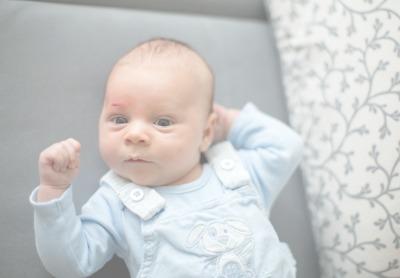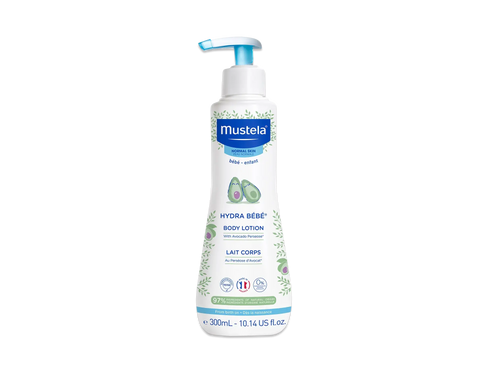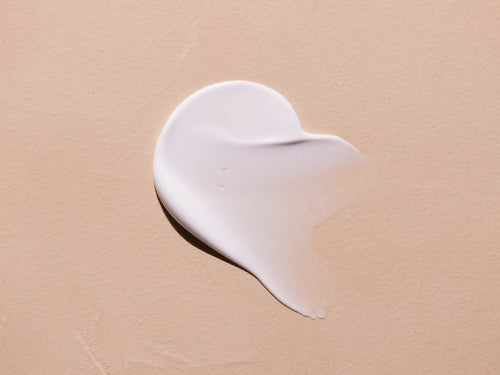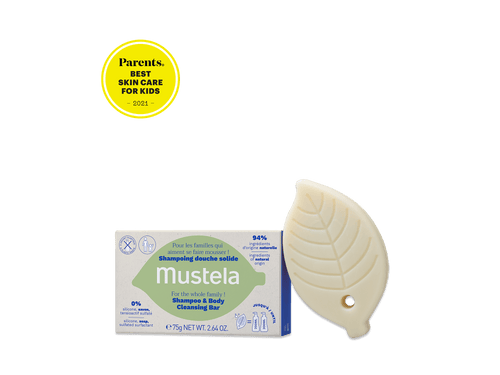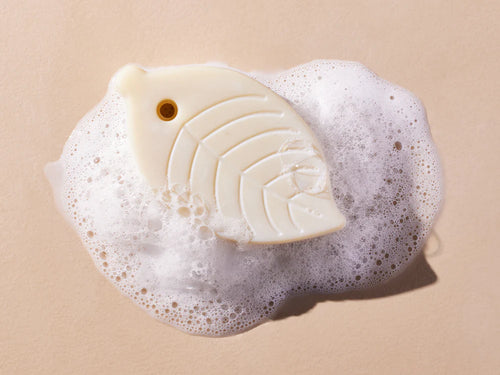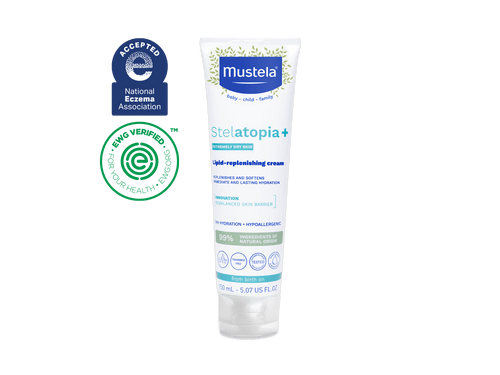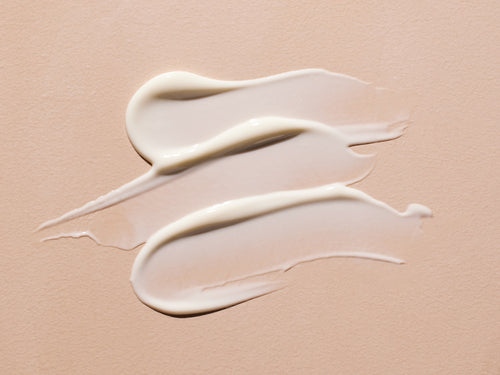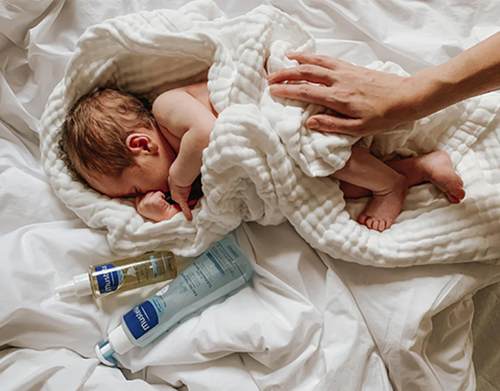Babies are curious and accidents happen, so cuts, scrapes, wounds, and bruises are inevitable for your little one. Most babies are soothed just by your touch, but sometimes their skin needs a little extra care based upon the severity of the injury and their skin type.
Continue reading to discover how to treat each incident so your baby’s skin can heal as quickly and with as little pain or discomfort as possible.
Table Of Contents
- Baby Wounds
- Baby Cuts
- Baby Scrapes
- Baby Scars
- Baby Bruises
- Preventing Baby Injuries
- FAQs About First Aid For Babies
- First Aid For Babies: Summing It All Up
Baby Wounds

According to the Merriam-Webster Dictionary, a wound is defined as “an injury to the body that typically involves laceration or breaking of a membrane (such as the skin) and usually damage to underlying tissues.”
As you may already know, the skin is the body’s largest organ. It plays many roles, including preventing viruses, bacteria, and fungi (which live on the surface) from entering the body.
This protection is compromised when you have a wound because the opening of the skin increases the chances of germs entering the body and causing an infection. That’s why treating wounds as quickly as possible is so important.
As much as you want to prevent your little one from getting hurt, odds are your baby will acquire some kind of wound in their lifetime. But don’t fret — we have the best treatment options to get your baby back on the go in no time!
Treatment
You can easily treat most of your baby’s wounds at home if you know how to stop the bleeding and apply a dressing.
Wash your hands before examining a wound, and apply direct pressure to the wound with a clean bandage or cloth until the bleeding stops. Elevate the wound above the level of your child’s heart to slow the bleeding. For example, prop your baby’s arm or leg up on a pillow.
After the bleeding slows down, follow these directions:
- Rinse the wound with clean water until all dirt or debris is removed.
- Wash the wound with warm water and rinse.
- Gently apply a small amount of Cicastela Moisture Recovery Cream.
- Place a bandage or gauze over the wound.
- Clean the area daily and apply Cicastela Moisture Recovery Cream until your baby’s wound is fully healed.
We also recommend our Arnica Gel once your baby is nine months or older. Formulated with calendula and other natural ingredients, this gel is designed to soothe boo-boos on babies without leaving their skin feeling greasy or sticky.
Keep in mind that no creams or gels should be used on broken skin or open wounds.
A Closer Look At The Healing Process
You may notice that a wound is red, swollen, and painful for the first few days. Before you start panicking, this inflammation doesn’t necessarily mean that something’s wrong.
In fact, these signs mean that your child’s immune system is working to protect the wound from any possible infection.
During the healing process, it’s essential to keep cleaning the wound by following the directions above. This will help prevent infections, which could make it take longer for your little one to fully heal.
After some time, you will notice a scab forming over the injured area. This is excellent news!
Healthline describes scabs as a “protective tissue that forms after your skin has been damaged…Your tissue will then regenerate, pushing out the scab to make room for new skin to grow in its place.”
Once the healing is complete and the scab falls off, it will reveal the new and repaired skin. Depending on the type of wound, this new skin may have a scar.
While it’s essential to treat the wound on the outside, focusing on what’s going on inside your child’s body can also help. It’s important to remember that your little one’s body relies on vitamins and minerals to heal and function properly.
Offer them a healthy, balanced diet. This should include lots of vitamin-rich fruits and veggies and lean proteins. Your child should also drink lots of water to stay hydrated and flush any toxins out of their body.
This approach (treating both inside and outside) will ensure that your little one's back to their old self in no time.
That being said, call your child’s doctor if the wound is:
- On their face
- Caused by a bite from an animal or another child
- Deep and caused by a dirty object (such as a nail)
- Showing signs of infection: redness, pus, oozing, or swelling
Take your child directly to the emergency room if:
- Bleeding doesn’t stop within 10 minutes of applied pressure
- You suspect the need for stitches
- The wound is embedded with dirt or some other debris
- Something large is stuck in their skin
Baby Cuts

Your baby can get a cut when an object pierces into their first layer of skin. Stitches are required for deep cuts. Here are some guidelines for cuts to determine if stitches are needed:
- Goes all the way through the skin
- Wide with visible dark red muscle or yellowish fat
- More than ½ an inch long
- Won’t stop bleeding
Note: Some small cuts may still require medical attention. If the cut is deep or is in a cosmetically sensitive area, such as the face, take your child to get examined by their pediatrician right away.
Treatment
To stop the bleeding, use gauze and apply pressure over the cut for five to 10 minutes. Then carefully clean the affected area with Mustela’s Gentle Soap with Cold Cream.
Soaking the area in the bathtub is another option if your child is resistant while you attempt to clean the cut. (Don’t do this for deep cuts because it may cause swelling to the laceration.)
After you clean your baby’s cut, apply a small amount of Mustela’s Cicastela Moisture Recovery Cream. It promotes skin recovery and helps nourish your baby’s delicate skin. And because this cream increases skin-healing properties, infections can be reduced.
With a little care and a lot of love, your baby’s cut will heal nicely!
Options For Closing A Cut

Deep cuts require different courses of treatment, so take a look at the options below.
Skin Glue
After examining your baby’s wound, your pediatrician will decide if skin glue is the best option. Your baby’s doctor will line up the wound edges as accurately as possible so the skin glue can be applied over the closed cut.
Skin glue is not as durable as stitches, but it’s a good choice for a straight cut. It’s quick and painless!
Steri-Strips
Steri-strips, better known as the butterfly bandage, are narrow adhesive strips that are placed over the cut. They are used for small cuts and can be applied at home or by your baby’s doctor.
Stitches
Stitches are the most durable option and must be administered by a doctor. However, stitches can be painful and require time and patience while putting them in.
There are two types of stitches: absorbable (need to be removed) and non-absorbable (do not need to be removed).
Staples
Staples are fast and are most often used for cuts in the scalp where the hair is involved. Staples are only administered by a doctor.
Baby Scrapes

Scrapes are surface wounds that don’t go all the way through the skin. You’ll often find scrapes on your baby’s elbows, knees, and palms from where they’ve fallen and tried to catch themselves.
Treatment
The first step is to try to calm your baby down, and then follow these steps:
- Apply direct pressure to your baby’s scrape for 10 minutes or until the bleeding stops.
- Wash the scrape with soap and water. Try Mustela’s Gentle Cleansing Gel to effectively clean and soothe your baby’s skin.
- Use a washcloth to gently scrub away any dirt.
- Apply Cicastela Moisture Recovery Cream to replenish and moisturize your baby’s skin.
- Cover the affected area with a bandage or gauze to prevent infection.
Baby Scars

When your baby’s wound starts to heal, the skin will naturally repair itself. The baby wound on top of the skin turns into a scab. The scab will fall off once the wound is fully healed.
Your baby’s skin may bounce back with no scarring or the wound may leave a scar.
Treatment
To reduce the appearance of scars, try these natural home remedies:
- Aloe Vera — Contains anti-bacterial and anti-fungal properties. Apply it to your baby’s scar and leave it on for 30 minutes. Apply up to twice per day.
- Coconut Oil — Acts as a thick, moisturizing barrier as your baby’s skin begins to heal. Warm the oil and gently massage it over your baby’s scar for about three minutes. Repeat up to three times per day.
- Cicastela Moisture Recovery Cream — Fragrance-free and formulated with a blend of restorative ingredients, including plant-derived hyaluronic acid, which hydrates to promote skin recovery. Apply twice per day.
Baby Bruises
Bruises develop when your baby takes a tumble or bumps into something — like falling when they’re learning to walk. This causes your baby’s capillaries — tiny blood vessels — to break and leak blood.
The affected area will look red, purple, or blue and then slowly fade to a greenish-yellow color. A bruise may appear right after a small trauma to the skin, or it may not show up until the next day.
Treatment
Apply a cold compress to ease the pain and swelling. There is no need to call your baby’s pediatrician for typical, occasional bruising. Provide an ice pack and give your little one some extra TLC.
However, the following are causes for concern, so give your baby’s pediatrician a call if you notice:
- Large bruises
- Ongoing pain
- Abdominal bruises
- Frequent, unexplained bruising
- A bruise that doesn’t fade or disappear after two weeks
- A bruise on a large joint that makes your child hesitant to move that joint
Note: If you notice frequent bruising after picking up your child from a caregiver or you have any suspicions of abuse, talk to your child’s pediatrician or reach out to the authorities right away.
Preventing Baby Injuries
Getting a skinned knee is a rite of passage for kids. They bore the battle wound from playing hard! And while there’s no preventing injuries 100 percent of the time, your baby’s skin isn’t necessarily inviting them in.
Once your baby is on the go, implement these safety tips:
- Place safety covers on all outlets
- Lock up any cabinets or drawers with sharp objects
- Store tools in locked containers
- Cover sharp edges (for example, coffee tables and fireplace edges)
- Scan yard and driveway for sharp objects
Tip: Keep Mustela’s No Rinse Cleansing Water and Cicastela Moisture Recovery Cream in your diaper bag for quick and easy care when boo-boos happen while you’re on the go!
FAQs About First Aid For Babies

Should I Buy A Baby First Aid Kit?
We’ve highlighted how challenging it is to avoid injuries in and around the house. This makes a baby first aid kit important.
Having one in your home will ensure that you have all the necessary supplies nearby when an accident does occur, and you won’t have to waste time running to the store.
You can get a standard first aid kit from many places, including online stores or your local drug store. If you have an infant, be sure to check that the kit you choose is for babies.
This is important because standard kits often have products that aren’t formulated for use on a baby’s soft, delicate skin.
Here’s what to look for when buying a first aid kit for your newborn:
- Nail clippers
- Saline drops
- Cotton balls
- Nasal aspirator
- Rectal thermometer
As your newborn gets older (i.e., passes the 6-month mark), you can adjust your kit accordingly. Your kit will now need to include the following:
- Bandages
- Gauze, scissors, and tape
- Alcohol wipes
- Hand sanitizer
- Gloves
- Medication for fever or pain (e.g, ibuprofen)
- Medication for allergic reactions
Note: Always double-check that any medications are age-appropriate and approved by your healthcare provider.
The above list highlights the basics that you’ll need for your baby’s first aid kit. And you may also want to add ointments and creams to use over the injured areas.
We’ve touched on some of our best creams and gels in this article, such as our Cicastela Moisture Recovery Cream and Arnica Gel. These products are both fragrance-free, dermatologically tested, and can deliver soothing relief for your little one’s minor accidents.
You can also add Stelatopia Emollient Face Cream to your arsenal to soothe, protect, and replenish your little one’s delicate skin on their face. This is a great product to use after extended sun exposure and to prevent any irritation.
How Can I Make My Child’s Scar Less Visible?

Firstly, it’s important to note that it’s impossible to erase the appearance of a scar completely. Once the scab falls off and the new skin appears, no treatment can return the new skin back to its old appearance.
You can, however, reduce the severity of the scar. Here’s a look at a couple of tried and tested tricks that have worked over the years.
Scar Massage
Start by placing your fingers on the injured area and applying moderate pressure. Then, massage the area by going in small circles. Doing this daily can help soften and flatten the scar quicker.
As you massage the area, apply Arnica Gel (for babies nine months and older) and Cicastela Moisture Recovery Cream to naturally moisturize the skin.
Sunscreen
Have you ever noticed how quickly damaged skin can get discolored after an injury? For this reason, it’s essential to minimize sun exposure until the area has completely healed.
This includes keeping the area covered. If the injury is on the face or head, keep their delicate skin shielded with a wide-brimmed hat.
Sunscreen can also play a part in reducing a scar’s visibility. You can apply sun protection, such as our SPF 50 Mineral Sunscreen Stick, a broad-spectrum SPF safe for babies, children, and the entire family.
This special sun protection also contains 70% organic ingredients, including natural oils such as shea butter, avocado oil, sunflower seed oil, and jojoba to give your little one’s skin the moisture it needs at all times.
Note: While applying sunscreen is essential, it should also be well-timed. Avoid using any sun protection on the affected area until at least two weeks after the injury. This helps the skin heal properly first.
How Do I Prevent My Baby From Getting Facial Cuts?
Babies and children haven’t learned how to keep themselves safe yet, so it can be challenging to completely eliminate the chances of them experiencing a cut or wound at least once in their lifetime.
However, there are a few measures you can take to help reduce the chance of injuries — particularly facial injuries — in children:
- Encourage your child to avoid running or even walking while they have something in their mouth.
- Teach your little one not to poke at or place objects (e.g., cotton swabs, pencils, etc.) in their nose or ears.
- As your child gets older and starts participating in sporting activities, always make sure they wear protective gear (for head, eyes, and face).
What Is The Best Way To Handle A Burn?

Before having a baby, you probably didn’t worry much about having a cup of coffee or hot iron lying around. But now that you have a little one, you’re much more aware of these safety concerns.
If your little one is crawling or moving around the house, there are a few ways to prepare for a potential burn incident.
What To Treat At Home
First-degree burns (when the outer layer of the skin is red but not blistering) are what you can treat at home.
To treat the burn, you’ll need to run cool water over the affected area for several minutes. This is an important step as it helps lower the skin temperature.
Many assume that they need to use icy-cold water, but this isn’t a great option because, in addition to feeling uncomfortable, this may reduce blood flow to the skin. We don’t want that!
After running the cool water for a few minutes, apply our Cicastela Moisture Recovery Cream for relief. You can use this a few times a day as needed.
Note: Avoid using home remedies such as butter or ice. These can, unfortunately, increase the size of the burn.
Over the next few days, clean the affected area with our Gentle Soap With Cold Cream to nourish and heal your little one’s damaged skin.
After every clean, remember to cover the area with a gauze to avoid infection.
When To Call The Doctor
Call your doctor immediately if your child has second-degree burns (blistering burns that affect both the outer and underlying layers of the skin).
If the burn is on your child’s genitals, face, hands, or feet, you may also need to call the doctor.
When assessing this type of injury, always call 911 immediately if your child has a severe burn (e.g., electrical burn) or isn’t breathing.
First Aid For Babies: Summing It All Up

As a parent, it’s scary when you notice blood on your baby. Knowing the different treatment methods for each type of injury — baby wounds, baby cuts, baby scrapes, baby scars, baby bruises — can help put your mind at ease.
Stay up to date on first aid procedures for your baby and remember to keep your Cicastela Moisture Recovery Cream on hand. You’ll be a pro at handling your baby’s injuries in no time!


